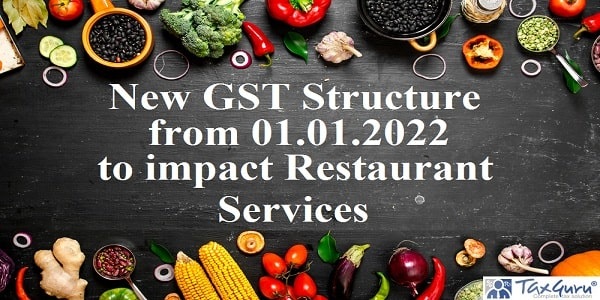GST Council has recommended on including Food Aggregators operating through Food Delivery Apps such as Zomato, Swiggy, cloud kitchens within the ambit of Restaurants services and make them liable to pay GST. This Article focusses on yet another changes brought in by the GST Council in their recent 45th Council meeting held on 17th September,2021 and this time it is on our food which is ordered from Restaurant via Food delivery Apps such as Swiggy, Zomato etc. Currently, the chain of GST payments while ordering food online is that the restaurants charge 5% GST on food bills to end Customers and the food aggregators charge an 18% GST commission from restaurants for delivery and marketing. All of the taxes are eventually included in the customer’s bill. Restaurants pay GST @18% on Commission charged by Food Aggregators and GST@5% collected from Customers was paid to Government.

It is now decided by the GST Council on its 45th GST Council Meeting that w.e.f 01st January, 2022 Food Aggregators shall be responsible for collecting GST from Customers and depositing it to the Government on its own account and companies such Zomato, Swiggy and other such Food Aggregator Services that deliver food services are likely among these covered by these decision.
This move will certainly help Government to curb revenue as there were many unregistered Restaurants (generally having turnover below Rs.20 Lakhs) who were delivering Foods via Food Aggregators and yet were not liable to pay GST and hence it will lead to the supplies by Smaller Restaurants operating below Rs.20 Lakh threshold limit becoming taxable.
This shift of collection of GST would not affect End Customers as there is no new Tax however it may impact the Compliances and Maintenance of Books of Accounts for Restaurants. They will have to maintain two separate books of accounts for their normal business and for food delivered through Zomato or Swiggy. They would be required to have smart book keeping and reconciliation measures probably pushing greater use of technology though pushing costs also towards the north.
As of now decision of Government is yet to be seen how cascading effect of tax will be addressed. For Instance when Swiggy pay GST for the consideration charged for home delivery, whether Swiggy will be eligible to avail credit of the procurements done from the restaurants. On the other hand, different restaurant services would invite different tax slabs i.e. 5%,12% and 18% it will only be clear how the GST council imposes tax collection — uniform 5% rate or 5% + 18% or different slabs for different restaurants or foods. The exact mechanics will only be clear once the language of the law is made clear.
The above Article is written by Suyash Tripathi and can be reached at tripathi.r.suyash@gmail.com






can resturant owner take ITC of that amount charged at 18 percent on swiggy Zomato fees
While the GST rate is not changed and there is no revenue loss,the shifting of tax incidence from Restaurants to food aggregators need not have been made so hastely.This might open Pandora’s box with similar demands from other sectors as well .There is likelihood of procedural difficulties for both the parties
I suggest a separate eating GST if the food ordered is consumed by more than one person at the end delivery point. A seperate book of accounts shall be maintained as to who are permanently resident at the address, who ordered delivery, who all were present and who all consumed. If more than one person consumed then the person who ordered shall collect 26% GST from each one who even tasted the delivered food and remit it to Government account.